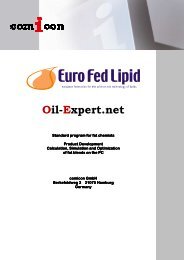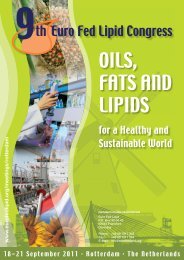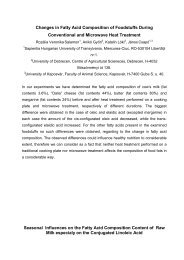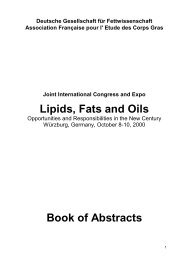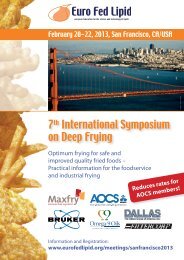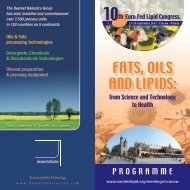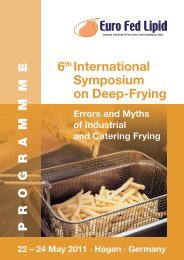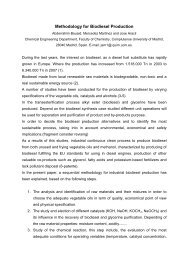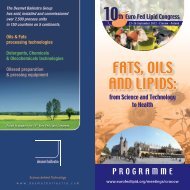Abstracts now available online - Euro Fed Lipid
Abstracts now available online - Euro Fed Lipid
Abstracts now available online - Euro Fed Lipid
You also want an ePaper? Increase the reach of your titles
YUMPU automatically turns print PDFs into web optimized ePapers that Google loves.
Physical and structural properties of caleosin, a protein probably<br />
involved in the mechanisms of lipid bodies maturation<br />
Zita Purkrtova 1,2 , Sabine d`Andrea 1 , Monique A.V. Axelos 3 , Petra Lipovova 2 , Blanka<br />
Kralova 2 and Thierry Chardot 1<br />
(1) CNRS-INRA-INAPG, Laboratoire de Chimie Biologique UMR 2585, Centre de<br />
Biotechnologie Agro-Industrielle, Thiverval-Grignon, 78850, France<br />
(2) The Institute of Chemical Technology, Department of Biochemistry and<br />
Microbiology, Technicka 3, Praha 6, Czech Republic<br />
(3) Unite de Physicochimie des Macromolecules, INRA, rue de la Geraudiere,<br />
Nantes cedex 3, 44316, France<br />
Plants store energy as polysaccharides or lipids. <strong>Lipid</strong>s are stored in intracellular<br />
oil particles called oil or lipid bodies, which can be found in all types of cells, but mainly<br />
in seeds. <strong>Lipid</strong> bodies are made up of a core containing mainly neutral lipids. The core<br />
is surrounded by a single monolayer of phospholipids embedded with structural proteins<br />
(oleosins). The function of oleosins is to maintain oil bodies in small stable droplets.<br />
Next to the oleosins the phospholipids monolayer contains also small amount of<br />
caleosin. Caleosin structure is oleosin-like but on the other hand unique thanks to the<br />
presence of calcium binding site.<br />
The mechanisms of lipid biosynthesis in plants is well k<strong>now</strong>n. However not so<br />
much is k<strong>now</strong>n about the process of formation and maturation of lipid bodies. <strong>Lipid</strong><br />
bodies are believed to arise from specific microdomains of the endoplasmic reticulum<br />
membrane that contain the full complement of TAG-biosynthesis enzymes. The small<br />
nascent lipid bodies undergo a series of fusions which led to a formation of mature lipid<br />
body. As achieving of correct size of lipid bodies is important for the life of cell, this<br />
process is highly regulated. The way of this regulation in plants is not k<strong>now</strong>n. The<br />
presence of calcium binding protein (caleosin) in mature lipid bodies and the similarity<br />
with the process of the formation of milk lipid globules in mammalian cells, could<br />
indicate that a cellular second messenger, calcium, and caleosin itself play an important<br />
role in the maturation process.<br />
For better understanding of caleosin role, structural and physical properties of<br />
caleosin were examined using different methods (Langmuir balance, pendant hanging<br />
drops and circular dichroism). Special emphasis were paid to the effect of calcium on<br />
these properties. Measurement were held with recombinant proteins. These proteins<br />
were prepared by cloning of one of A. thaliana caleosin genes (At4g26740) in two<br />
different bacterial expression systems and their purification to electrophoretic<br />
homogeneity.<br />
P6




